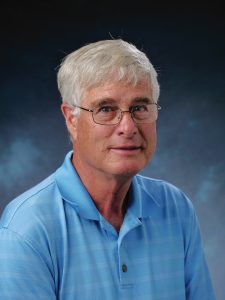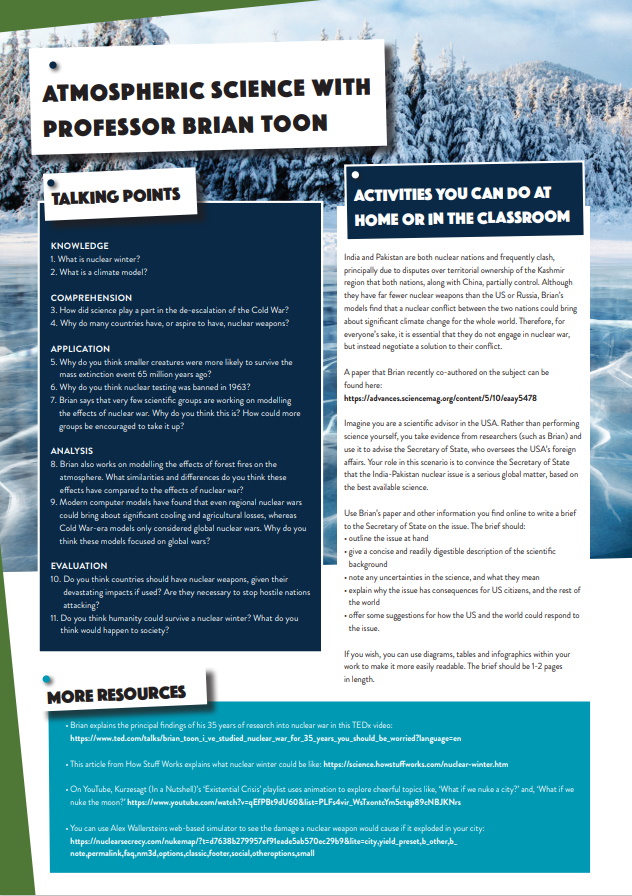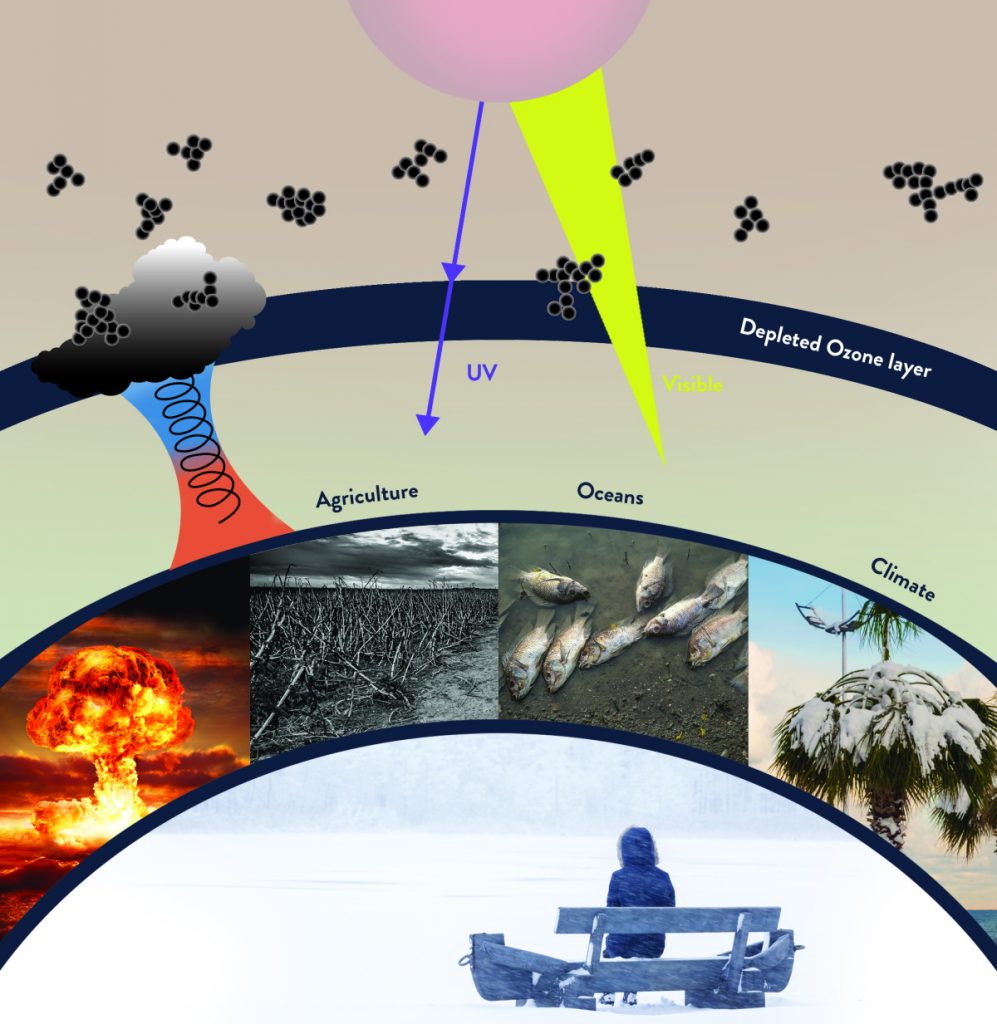Fire and ice: what nuclear war would mean for the planet
Everyone knows that the detonation of nuclear weapons would be very bad news, but their devastation is not only limited to their immediate impacts. Professor Brian Toon, of the University of Colorado Boulder in the US, is a veteran of atmospheric modelling, particularly the effects of nuclear weapons on the climate. The predictions of his models even helped influence world leaders to move away from nuclear warfare
TALK LIKE AN ATMOSPHERIC SCIENTIST
CLIMATE MODELLING – computer models that simulate the Earth’s climate and can be used to project past and future climates.
COLD WAR – a long period of political tension between the USA and Russia, from the late 1940s and ending in 1991 with the dissolution of the Soviet Union. It was characterised by threats of nuclear attacks from both sides – although none happened, mainly for fear of mutual annihilation.
NUCLEAR WEAPON – a bomb or missile that creates an explosion through nuclear fission and/or fusion. Also known as an atomic bomb.
NUCLEAR WINTER – a period of prolonged cold and darkness following a nuclear war, due to smoke and dust in the atmosphere blocking the sun’s rays.
STRATOSPHERE – the layer of atmosphere that begins about 7 miles from the Earth’s surface, directly above the layer where clouds and rain form (troposphere).
The history of nuclear weapons is not pleasant. Nuclear warheads were first developed and deployed by the US during World War II, with the devastating bombings of Hiroshima and Nagasaki. Though they have not been used aggressively since then, the tensions of the Cold War led to well-justified fears that a nuclear war between the US and Russia could be imminent. The nations’ leaders eventually backed down when scientists shared their discoveries that such a war could lead to a global nuclear winter and mass starvation due to the inability to grow food.
Although the quantity of nuclear weapons in the world has decreased by a factor of 5 since the mid-1980s, the 14,000 that remain could do immense harm. Despite nations’ claims that the weapons’ existence is simply a deterrent, global tensions mean nuclear war remains a distinct possibility.
Professor Brian Toon, of the University of Colorado at Boulder in the US, has spent decades predicting what effects nuclear war would have on society. He and his research group use sophisticated computer programs to model the world’s atmosphere and to see how it could change in different nuclear scenarios. His findings have informed global leaders, making sure they are aware about the dire consequences of nuclear conflict.
CLIMATE MODELLING
Most science relies on experimentation, but this is simply not possible when predicting the effects of nuclear wars. Instead, scientists turn to computer modelling, which takes certain inputs, for example the amount of smoke injected into the atmosphere by fires started by nuclear explosions, and calculates a projected outcome for a scenario, such as the changes in climate and impacts on agriculture and fisheries. Modelling the future of the Earth’s climate is especially important in today’s world, as we need to understand the effects of a rapidly changing climate. The same climate models can be used to predict the effect of other global scenarios, such as nuclear wars.
As computers have become increasingly sophisticated, so have computer models. They better capture the complexities of the real world and their predictions are more accurate. More recent models for predicting the effects of a nuclear war have resulted in a worrying conclusion: even a relatively modest nuclear war, such as between India and Pakistan, could have a profound global impact. Localised conflicts could have devastating worldwide effects; the decisions of Pakistani and Indian politicians and generals could lead to starvation throughout the rest of the world.
GOING NUCLEAR
Any good model uses evidence from past events to inform predictions. “We know a lot about the immediate, local effects of nuclear detonations because over 500 nuclear bombs were detonated in the atmosphere before testing was banned in 1963,” says Brian. “However, these tests were conducted in deserts or on small islands, to prevent the outbreak of huge fires.” It is fires that most concern Brian – if nuclear weapons were to target cities, they are expected to alight massive blazes. Cities contain a lot of fuel to burn through, much more than forests. The fires and explosions would kill tens or hundreds of millions of people. The single, small nuclear weapon dropped on Hiroshima, Japan, in World War II is thought to have killed around 100,000 people. However, these local effects of nuclear explosions are not the greatest danger to the world.
Where there is fire, there is smoke – and the smoke generated could have world-changing effects. “A lot of the smoke produced would enter the stratosphere,” says Brian. “This smoke would spread across the globe within a few weeks, cooling the planet’s surface by nuclear winter, we have to look for analogous events deep in the planet’s past. One planet-shaking event that shaped the course of life on Earth stands out.
66 million years ago, an asteroid the size of Everest struck the Earth, in what is now Mexico, at a speed 10 times that of a bullet from a rifle. Ultimately, the impact killed off about three-quarters of all species, including all the dinosaurs, except those avian dinosaurs that remain with us today as birds. “The asteroid impact had the energy of 100 million of the largest nuclear weapons,” says Brian. “The asteroid impact started fires that burned practically everything on Earth’s surface. After the initial catastrophic effects, a huge volume of soot remained in the atmosphere for about 10 years. Remnants of the smoke are still found in the geologic layers marking the extinction. This smoke absorbed all the sunlight, freezing the Earth’s surface and heating the stratosphere to such high temperatures that it destroyed the ozone layer.” For those creatures that survived the initial event, the next few years were desperately challenging. Starvation and exposure led to the demise of entire species.
Although there are still many unknowns about the effects of the asteroid, smaller events within relatively recent human history lend crucial insights. “The huge eruption of the Tambora volcano in Indonesia in 1815 impacted the entire world,” says Brian. “It was followed by the ‘year without a summer’, as the cooling effect of the particles in the stratosphere, in this case made of sulfuric acid instead of smoke, caused crop losses across the globe.” Because of the massive fires caused by nuclear weapons, especially when targeting urban areas, it is likely that nuclear war would result in a similar scenario – or even worse, depending on the scale of the conflict.
 PROFESSOR BRIAN TOON
PROFESSOR BRIAN TOON
Professor of Atmospheric and Oceanic Sciences, Laboratory for Atmospheric and Space Physics, University of Colorado Boulder, USA.
FIELD OF RESEARCH: Atmospheric and Planetary Sciences
RESEARCH PROJECT: Using computer models to predict the outcomes of nuclear war, in particular its implications for the global atmosphere.
FUNDERS: Open Philanthropy Foundation
Reference
https://doi.org/10.33424/FUTURUM115
CLIMATE MODELLING – computer models that simulate the Earth’s climate and can be used to project past and future climates.
COLD WAR – a long period of political tension between the USA and Russia, from the late 1940s and ending in 1991 with the dissolution of the Soviet Union. It was characterised by threats of nuclear attacks from both sides – although none happened, mainly for fear of mutual annihilation.
NUCLEAR WEAPON – a bomb or missile that creates an explosion through nuclear fission and/or fusion. Also known as an atomic bomb.
NUCLEAR WINTER – a period of prolonged cold and darkness following a nuclear war, due to smoke and dust in the atmosphere blocking the sun’s rays.
STRATOSPHERE – the layer of atmosphere that begins about 7 miles from the Earth’s surface, directly above the layer where clouds and rain form (troposphere).
The history of nuclear weapons is not pleasant. Nuclear warheads were first developed and deployed by the US during World War II, with the devastating bombings of Hiroshima and Nagasaki. Though they have not been used aggressively since then, the tensions of the Cold War led to well-justified fears that a nuclear war between the US and Russia could be imminent. The nations’ leaders eventually backed down when scientists shared their discoveries that such a war could lead to a global nuclear winter and mass starvation due to the inability to grow food.
Although the quantity of nuclear weapons in the world has decreased by a factor of 5 since the mid-1980s, the 14,000 that remain could do immense harm. Despite nations’ claims that the weapons’ existence is simply a deterrent, global tensions mean nuclear war remains a distinct possibility.
Professor Brian Toon, of the University of Colorado at Boulder in the US, has spent decades predicting what effects nuclear war would have on society. He and his research group use sophisticated computer programs to model the world’s atmosphere and to see how it could change in different nuclear scenarios. His findings have informed global leaders, making sure they are aware about the dire consequences of nuclear conflict.
CLIMATE MODELLING
Most science relies on experimentation, but this is simply not possible when predicting the effects of nuclear wars. Instead, scientists turn to computer modelling, which takes certain inputs, for example the amount of smoke injected into the atmosphere by fires started by nuclear explosions, and calculates a projected outcome for a scenario, such as the changes in climate and impacts on agriculture and fisheries. Modelling the future of the Earth’s climate is especially important in today’s world, as we need to understand the effects of a rapidly changing climate. The same climate models can be used to predict the effect of other global scenarios, such as nuclear wars.
As computers have become increasingly sophisticated, so have computer models. They better capture the complexities of the real world and their predictions are more accurate. More recent models for predicting the effects of a nuclear war have resulted in a worrying conclusion: even a relatively modest nuclear war, such as between India and Pakistan, could have a profound global impact. Localised conflicts could have devastating worldwide effects; the decisions of Pakistani and Indian politicians and generals could lead to starvation throughout the rest of the world.
GOING NUCLEAR
Any good model uses evidence from past events to inform predictions. “We know a lot about the immediate, local effects of nuclear detonations because over 500 nuclear bombs were detonated in the atmosphere before testing was banned in 1963,” says Brian. “However, these tests were conducted in deserts or on small islands, to prevent the outbreak of huge fires.” It is fires that most concern Brian – if nuclear weapons were to target cities, they are expected to alight massive blazes. Cities contain a lot of fuel to burn through, much more than forests. The fires and explosions would kill tens or hundreds of millions of people. The single, small nuclear weapon dropped on Hiroshima, Japan, in World War II is thought to have killed around 100,000 people. However, these local effects of nuclear explosions are not the greatest danger to the world.
Where there is fire, there is smoke – and the smoke generated could have world-changing effects. “A lot of the smoke produced would enter the stratosphere,” says Brian. “This smoke would spread across the globe within a few weeks, cooling the planet’s surface by nuclear winter, we have to look for analogous events deep in the planet’s past. One planet-shaking event that shaped the course of life on Earth stands out.
66 million years ago, an asteroid the size of Everest struck the Earth, in what is now Mexico, at a speed 10 times that of a bullet from a rifle. Ultimately, the impact killed off about three-quarters of all species, including all the dinosaurs, except those avian dinosaurs that remain with us today as birds. “The asteroid impact had the energy of 100 million of the largest nuclear weapons,” says Brian. “The asteroid impact started fires that burned practically everything on Earth’s surface. After the initial catastrophic effects, a huge volume of soot remained in the atmosphere for about 10 years. Remnants of the smoke are still found in the geologic layers marking the extinction. This smoke absorbed all the sunlight, freezing the Earth’s surface and heating the stratosphere to such high temperatures that it destroyed the ozone layer.” For those creatures that survived the initial event, the next few years were desperately challenging. Starvation and exposure led to the demise of entire species.
Although there are still many unknowns about the effects of the asteroid, smaller events within relatively recent human history lend crucial insights. “The huge eruption of the Tambora volcano in Indonesia in 1815 impacted the entire world,” says Brian. “It was followed by the ‘year without a summer’, as the cooling effect of the particles in the stratosphere, in this case made of sulfuric acid instead of smoke, caused crop losses across the globe.” Because of the massive fires caused by nuclear weapons, especially when targeting urban areas, it is likely that nuclear war would result in a similar scenario – or even worse, depending on the scale of the conflict.
 PROFESSOR BRIAN TOON
PROFESSOR BRIAN TOON
Professor of Atmospheric and Oceanic Sciences, Laboratory for Atmospheric and Space Physics, University of Colorado Boulder, USA.
FIELD OF RESEARCH: Atmospheric and Planetary Sciences
RESEARCH PROJECT: Using computer models to predict the outcomes of nuclear war, in particular its implications for the global atmosphere.
FUNDERS: Open Philanthropy Foundation
ABOUT ATMOSPHERIC SCIENCE
Brian’s work is very varied and leads him across many scientific disciplines.
WHAT DO YOU FIND MOST REWARDING ABOUT YOUR FIELD OF RESEARCH?
I enjoy working with students and other colleagues. However, it can be challenging to find the funds needed to support students – it can cost half a million dollars to take one graduate student to a PhD.
IS THERE A LOT OF RANGE IN YOUR WORK?
Currently, in addition to the nuclear winter studies, I work with students and colleagues to investigate volcanic clouds, rivers on ancient Mars, the climates of exoplanets, the distant past and future climates of Earth, the extinction of the dinosaurs, Asian air pollution during the monsoon season, loss of ozone in the polar regions as in the ozone hole, and simulation of clouds in climate models. I also teach. As well as all of these, I am involved with several satellite projects, and other projects using NSF and NASA high-altitude aircraft.
WHAT COLLABORATIONS DOES YOUR WORK INVOLVE?
I work with hundreds of people, mostly on large field studies involving NASA aircraft studying atmospheric clouds, chemistry and climate. These projects take huge numbers of people to carry out and many years to work on the data. Even computer modelling takes a lot of students and researchers to tackle the various aspects of the problems at hand.
WHAT WILL BE THE MAIN CHALLENGES FOR TOMORROW’S ATMOSPHERIC SCIENTISTS?
Climate change is going to have a major impact in coming decades. We will be forced to adapt to rising sea levels and extreme temperatures, among many other effects. Hopefully, we can find ways to mitigate this problem, but to do this we need a complete overhaul of our energy production systems, which is a major technical and political challenge. Climate change will also lead to increases in conflict and immigration, which could make nuclear war more likely – something that it is crucial to avoid.
HOW TO BECOME AN ATMOSPHERIC SCIENTIST
• A career in atmospheric science can be approached from many backgrounds. While many undergraduates study meteorology or atmospheric science, one can also study any of the major science fields such as physics, chemistry, biology or engineering. According to QS World University Rankings, the best universities for Natural Sciences (as an example subject) are MIT, Harvard, Stanford, Cambridge and Oxford. The University of Colorado at Boulder is one of the leading Geosciences universities in the world, along with the California Institute of Technology.
• Many institutions offer internships covering atmospheric science:
https://www.pathwaystoscience.org/Discipline.aspx?sort=EARAtmosphericSci_Atmospheric%20Sciences
• According to CareerExplorer, the average annual salary for an atmospheric scientist in the US is around $95k.
Brian says that people can get into atmospheric science from almost any background but recommends getting a solid background in the fundamental sciences – physics, chemistry and biology. He emphasises that atmospheric science is a multidisciplinary field and needs people from a wide range of backgrounds, such as engineering and computer science.
HOW DID BRIAN BECOME AN ATMOSPHERIC SCIENTIST?
My family moved every few years because my father was a naval aviator, so I had to make new friends constantly. We had many pets, and I also spent a lot of time swimming, fishing and being outdoors whenever possible. I enjoyed reading, especially books by famous scientists, as an effort to try and understand the world around me.
I grew up in an age when many young people were being encouraged to pursue science, through efforts in the media and breakthroughs around the world such as the Sputnik satellite. My mother bought me many science books which I devoured, and from that point on I have spent my life trying to understand scientific mysteries.
Successful scientists are driven to understand the issues that interest them. There is a bit of luck needed sometimes, but mostly it comes down to determination and hard work. I find that the students who do best are not necessarily those recognised as the smartest, but rather those most determined to pursue their dreams.
I encounter obstacles on a daily basis! I try not to let myself get side-tracked on minor issues, and I also diversify my work so if one area reaches a barrier, I can move forward with another. I am also tenacious; I have been working on some problems for nearly fifty years and there is still disagreement about the solutions. Nevertheless, great progress has been made.
As well as my scientific discoveries, many of my proudest moments relate to the interaction of science with world affairs. I am proud to have helped influence the US and Russian leaders during the Cold War to sign a treaty to limit intermediate range nuclear weapons through the development of the nuclear winter theory. Since then, I am proud to have been recognised for contributing to the Nobel Peace Prize awarded to the UN and Al Gore for research on climate change. I am also proud of my work on understanding the ozone hole including predicting the occurrence of nitric acid clouds in the polar night. Finally, I am also very proud of the many students who have worked with me and gone on to have great careers of their own.
BRIAN’S TOP TIPS
01 Figure out what you are passionate about and pursue it – but don’t be afraid to change direction if your interests change.
02 Take the opportunities that are available to you. You may not be asked twice!
03 Never give up. Science can take a long time and suffer many setbacks, but the resultant breakthroughs make it worth it.
Write it in the comments box below and Brian will get back to you. (Remember, researchers are very busy people, so you may have to wait a few days.)









How do would Nuclear Winter affect long-term precipitation in California? I read that a full-scale city-on-city nuclear exchange between the US and NATO vs. Russia and China would trigger a 7-8-year-long super El Nino due to the severe cooling of the atmosphere but with the ocean retaining its heat for a longer period of time, enhancing the temperature contrast between the chilled atmosphere and the relatively warm ocean. Would that supercharge cold-season atmospheric “rivers” and bomb cyclones off the west coast in the same fashion as a scaled-up Lake Affect snowstorm back East?
You can read our detailed discussion of a Nuclear El Nino at https://www.nature.com/articles/s43247-020-00088-1.
Basically in a Nuclear Winter temperatures drop to sub ice age levels because sunlight is absorbed by smoke in the stratosphere rather than reaching the ground. With less sunlight, there is less evaporation of water from the oceans, so there is less precipitation. We estimate a precipitation loss of about 55% globally. However, California seems to experience only a small loss of rainfall.
Due to cold temperatures and lowered rainfall our latest research shows that massive agricultural failures will occur following a war between the U.S., NATO, Russia and China. As a result the majority of Earth’s population will not have enough food and die by starvation. High latitude countries, such as Russia, will have the greatest death rates.